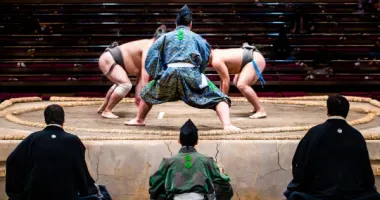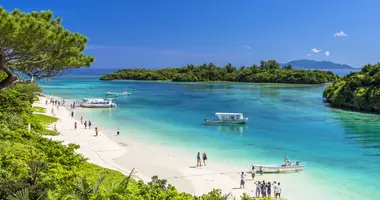Izu Oshima Island
- Published on : 13/05/2019
- by : J.R.
- Youtube
The volcanic island near Tokyo
The island of Izu Oshima, Tokyo prefecture, is a pleasant place to visit nature for a day or two. Exotic landscapes, trekking, relaxation in onsen or walks in the forest... The island has a lot to offer, less than 2 hours from Tokyo!
Izu Oshima Island is a large volcanic island that is part of the Izu archipelago. It is located 120 kilometers off Tokyo, east of the famous Izu Peninsula. It is the largest of the islands of Izu, and the closest to the capital, which makes it the most visited. It can be reached in 1h45 from Tokyo by Jet Ferry (a kind of catamaran), or in 6 hrs by ferry.
Like all of its archipelago, it is part of the Fuji-Hakone-Izu National Park. The highest point of the island is its volcano, Mount Mihara, which rises to 764 meters above sea level and whose last explosive eruption dates back to 1986. This volcano is very well known to the Japanese because it is the home of Godzilla in the movies. It is also nicknamed the "volcano of lovers", because it is in its crater that, according to legend, heartbroken lovers would throw themselves.
- To read: Japanese volcanoes
The volcano on the island
Once you arrive at the port of Oshima, you will have the choice between crisscrossing the island by bus, or by renting a car or a bicycle, which are more practical than public transportation.
The main attraction of the island is its volcano, located in its center. The ascent takes about 1 hour, and you can, once at the top, go around the crater (300 meters in diameter, all the same!) and admire the spectacular view.
In good weather, it is possible to see Mount Fuji.
At the foot of one of the flanks is also the Ura-Sabaku desert, marked by vast expanses of black sand. A hike not to be missed since it is the only desert in Japan! The latter took his face because of the lava flows from the Mihara volcano.
Beaches, hikes, and onsen
There are many other activities to do while visiting the island, for one or two days. In addition to the volcano, the island is recommended for enjoying the beaches on sunny days, and doing some snorkeling on its coasts. Toshiki beach is the favorite place of the Japanese to admire fish of all kinds but also sea turtles. The beach of Sa-no-hama and its impressive black sand is also a curiosity not to be missed...
Don't miss either Fudeshima beach (on the east coast) and its typical rock, which the Japanese liken to the tip of a calligraphy brush.
- To discover: The beaches near Tokyo
Fans will also go for a walk around the Hajikama sanctuary, located in the middle of a cedar forest and thus promising a beautiful walk.
Due to the volcanic nature of the island, there are many onsens on its land. The curious can choose to spend a night in a ryokan to enjoy it, or to spend an hour or two in one of the natural hot springs, for example at Onsen Miharayama, or that of Hama-no-yu, which is mixed and therefore requires a swimsuit.
- Read also: 5 spa towns near Tokyo
For children, also know that there is a zoo and a squirrel park on the island.
Finally, the island is very famous for its camellias, which are one of the symbols of the island. Flowering usually takes place between January and March. So, if you visit Oshima Island in March, be sure to take advantage of the festival held every year to admire the flowers. Oshima Park is then the place where you can admire the most varieties of camellias.
How to get there?
There are several ways to get to the island. First is the plane, the fastest way but also the most expensive. You can reach the island in 25 minutes from Chofu Airport in Tokyo.
Those who prefer the boat will have the choice between a fast ferry (a hydrofoil catamaran) which departs daily from the Takeshiba ferry terminal and reaches the island in just under 2 hrs.
There is also a classic ferry, similar to those used to reach Corsica, which makes the trip in 5 to 7 hrs and is more economical. It is the company Tokai Kisen which manages these ferries. Jet ferries are in operation daily starting in the spring, with several running daily.
Be careful, however, the last leaves the island around 4:30 pm, often earlier in spring and autumn.






































